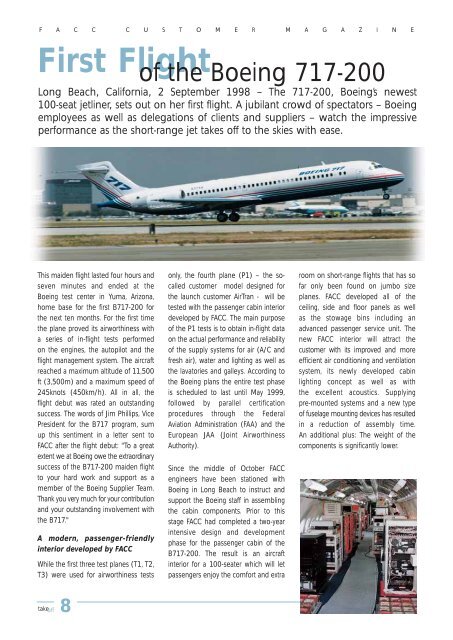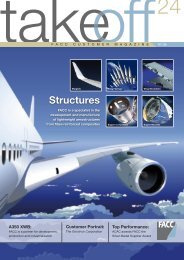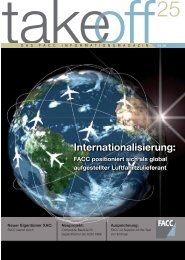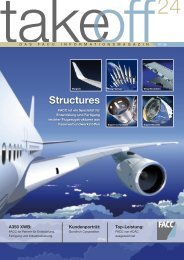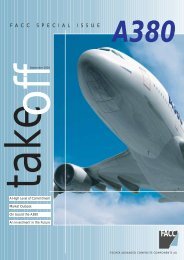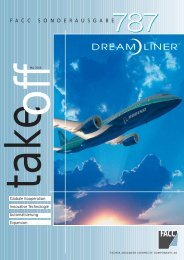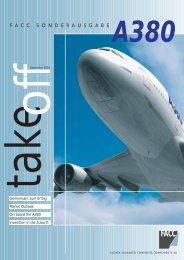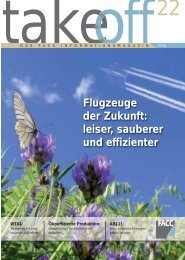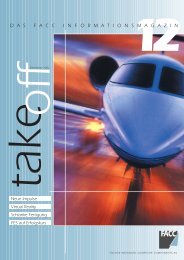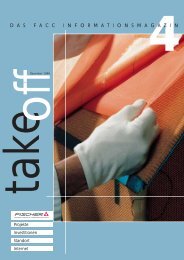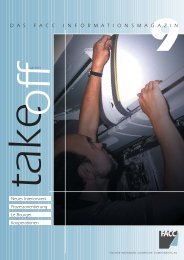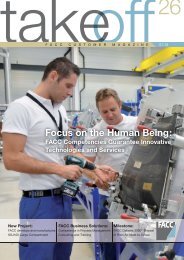Create successful ePaper yourself
Turn your PDF publications into a flip-book with our unique Google optimized e-Paper software.
F A C C C U S T O M E R M A G A Z I N E<br />
First Flight<br />
of the Boeing 717-200<br />
Long Beach, California, 2 September 1998 – The 717-200, Boeing’s newest<br />
100-seat jetliner, sets out on her first flight. A jubilant crowd of spectators – Boeing<br />
employees as well as delegations of clients and suppliers – watch the impressive<br />
performance as the short-range jet <strong>take</strong>s off to the skies with ease.<br />
This maiden flight lasted four hours and<br />
seven minutes and ended at the<br />
Boeing test center in Yuma, Arizona,<br />
home base for the first B717-200 for<br />
the next ten months. For the first time<br />
the plane proved its airworthiness with<br />
a series of in-flight tests performed<br />
on the engines, the autopilot and the<br />
flight management system. The aircraft<br />
reached a maximum altitude of 11,500<br />
ft (3,500m) and a maximum speed of<br />
245knots (450km/h). All in all, the<br />
flight debut was rated an outstanding<br />
success. The words of Jim Phillips, Vice<br />
President for the B717 program, sum<br />
up this sentiment in a letter sent to<br />
<strong>FACC</strong> after the flight debut: "To a great<br />
extent we at Boeing owe the extraordinary<br />
success of the B717-200 maiden flight<br />
to your hard work and support as a<br />
member of the Boeing Supplier Team.<br />
Thank you very much for your contribution<br />
and your outstanding involvement with<br />
the B717."<br />
A modern, passenger-friendly<br />
interior developed by <strong>FACC</strong><br />
While the first three test planes (T1, T2,<br />
T3) were used for airworthiness tests<br />
<strong>take</strong>off<br />
8<br />
only, the fourth plane (P1) – the socalled<br />
customer model designed for<br />
the launch customer AirTran - will be<br />
tested with the passenger cabin interior<br />
developed by <strong>FACC</strong>. The main purpose<br />
of the P1 tests is to obtain in-flight data<br />
on the actual performance and reliability<br />
of the supply systems for air (A/C and<br />
fresh air), water and lighting as well as<br />
the lavatories and galleys. According to<br />
the Boeing plans the entire test phase<br />
is scheduled to last until May 1999,<br />
followed by parallel certification<br />
procedures through the Federal<br />
Aviation Administration (FAA) and the<br />
European JAA (Joint Airworthiness<br />
Authority).<br />
Since the middle of October <strong>FACC</strong><br />
engineers have been stationed with<br />
Boeing in Long Beach to instruct and<br />
support the Boeing staff in assembling<br />
the cabin components. Prior to this<br />
stage <strong>FACC</strong> had completed a two-year<br />
intensive design and development<br />
phase for the passenger cabin of the<br />
B717-200. The result is an aircraft<br />
interior for a 100-seater which will let<br />
passengers enjoy the comfort and extra<br />
room on short-range flights that has so<br />
far only been found on jumbo size<br />
planes. <strong>FACC</strong> developed all of the<br />
ceiling, side and floor panels as well<br />
as the stowage bins including an<br />
advanced passenger service unit. The<br />
new <strong>FACC</strong> interior will attract the<br />
customer with its improved and more<br />
efficient air conditioning and ventilation<br />
system, its newly developed cabin<br />
lighting concept as well as with<br />
the excellent acoustics. Supplying<br />
pre-mounted systems and a new type<br />
of fuselage mounting devices has resulted<br />
in a reduction of assembly time.<br />
An additional plus: The weight of the<br />
components is significantly lower.


